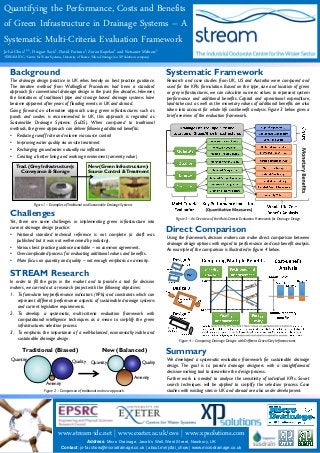
Quantifying the Performance, Costs and Benefits of Green Infrastructure in Drainage Systems
- 1. Quantifying the Performance, Costs and Benefits of Green Infrastructure in Drainage Systems – A Systematic Multi-Criteria Evaluation Framework Jo-fai Chow1,2,3, Dragan Savic2, David Fortune3, Zoran Kapelan2 and Netsanet Mebrate3 1STREAM IDC, 2Centre for Water Systems, University of Exeter, 3Micro Drainage (an XP Solutions company) Background The drainage design practice in UK relies heavily on best practice guidance. The iterative method from Wallingford Procedures had been a standard approach for conventional drainage design in the past few decades. However, the limitations of traditional pipe and storage based drainage systems have become apparent after years of flooding events in UK and abroad. Going forward, an alternative approach using green infrastructures such as ponds and swales is recommended. In UK, this approach is regarded as Sustainable Drainage Systems (SuDS). When compared to traditional methods, the green approach can deliver following additional benefits: • Reducing runoff rate and volume via source control • Improving water quality via on-site treatment • Recharging groundwater naturally via infiltration • Creating a better living and working environment (amenity value) Trad. (Grey Infrastructure): Conveyance & Storage Systematic Framework Research and case studies from UK, US and Australia were compared and used for the KPIs formulation. Based on the type, size and location of green or grey infrastructures, we can calculate numeric values to represent system performance and additional benefits. Capital and operational expenditure, land-take cost as well as the monetary values of additional benefits are also taken into account for whole life cost-benefit analysis. Figure 3 below gives a brief overview of the evaluation framework. New (Green Infrastructure): Source Control & Treatment Figure 1 – Examples of Traditional and Sustainable Drainage Systems Challenges Yet, there are some challenges in implementing green infrastructure into current drainage design practice: • National standard technical reference is not complete (a draft was published but it was not well-received by industry). • Various best practice guidance available – no common agreement. • Overcomplicated process for evaluating additional values and benefits. • Main focus on quantity and quality – not enough emphasis on amenity. Figure 3 – An Overview of the Multi-Criteria Evaluation Framework for Drainage Design Direct Comparison Using the framework, decision makers can make direct comparison between drainage design options with regard to performance and cost-benefit analysis. An example of the comparison is illustrated in figure 4 below. STREAM Research In order to fill the gaps in the market and to provide a tool for decision makers, we carried out a research project with the following objectives: 1. To formulate key performance indicators (KPIs) and constraints which can represent different performance aspects of sustainable drainage systems and current legislative requirements. 2. To develop a systematic, multi-criteria evaluation framework with computational intelligence techniques as a mean to simplify the green infrastructures selection process. 3. To emphasis the importance of a well-balanced, economically viable and sustainable drainage design. Traditional (Biased) Quantity Quality New (Balanced) Quantity Quality Amenity Amenity Figure 2 – Comparison of traditional and new approach. Figure 4 – Comparing Drainage Designs with Different Green/Grey Infrastructures Summary We developed a systematic evaluation framework for sustainable drainage design. The goal is to provide drainage designers with a straightforward decision-making tool to streamline the design process. Further work is needed to analyse the sensitivity of individual KPIs. Smart search techniques will be applied to simplify the selection process. Case studies with existing sites in UK and abroad are also under development. www.stream-idc.net/ Address: Micro Drainage, Jacob’s Well, West Street, Newbury, UK Contact: jo-fai.chow@microdrainage.co.uk | about.me/jofai_chow | www.microdrainage.co.uk ww.stream-idct www.stream-idc.net | www.exeter.ac.uk/cws | www.xpsolutions.com
